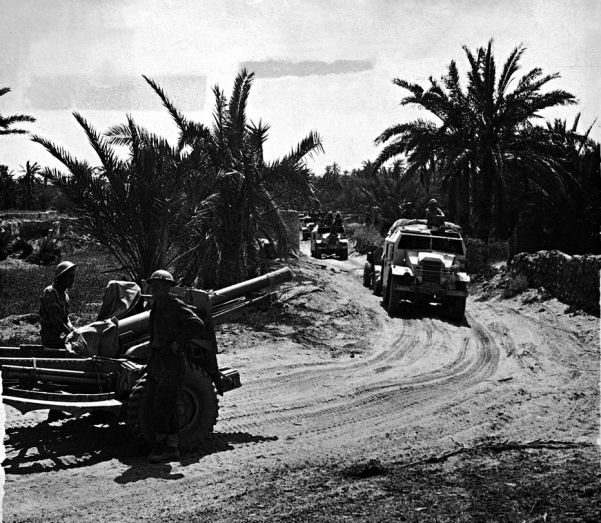5-6 April
Africa, Tunisia
The British Eighth Army attacks the Wadi Akarit Line, a defensive position situated across the route into Tunisia. The line cannot be outflanked. While the assault is successful, the British fail to exploit their breakthrough and Axis forces are able to regroup.
7-10 April
Africa, Tunisia
The British IX Corps, which includes the US 34th Infantry Division, attacks the Foundouk Pass but the Axis forces hold the area until they can successfully disengage the bulk of their units from the fighting.
7-13 April
Air War, Solomons
Over 180 Japanese aircraft begin Operation I by attacking Allied shipping off Guadalcanal. On the 11th, the Japanese attack ships off New Guinea and raid Port Moresby airfield on the 12th, and British at Milne Bay the following day. They sink a destroyer, one corvette, one tanker, two cargo ships, and destroy some 20 aircraft. The massive aerial operation against shipping and airfields, however, does not achieve the scale of success that the Japanese anticipated.
8 April
Politics, Japan
General Kawbe succeeds General Iida as commander of Japanese forces operating in Burma.
10-12 April
Africa, Tunisia
British troops enter Sfax, one of the ports vital for reducing the long supply lines from Tripoli, and finally halt at Enfidaville, southeast of Tunis. Axis forces are now established in their final defensive line running from Cape Serrat on the Mediterranean to Enfidaville. Defeat for the Axis forces is inevitable. Allied sea and air control denies them any reinforcements. They are determined to fight on, however, in order to delay the Allied plan to invade Italy until the fall, when deteriorating weather is likely to disrupt any Allied landings.
12 April
Home Front, Poland
The German authorities announce that they have found a mass grave in Katyn Forest. They claim that it contains the bodies of some 10,000 Polish officers executed by the Soviet secret police in 1939. The Soviets claim that this is deliberate German propaganda aimed at discrediting them. Subsequent investigations reveal the Soviets were indeed responsible for the massacre of 4500 officers at Katyn Forest.
17 April
Air War, Germany
The US 8th Army Air Force attacks Bremen’s aircraft factories from its bases in Eastern England. It is one of its largest raids to date. Sixteen of the 115 B-17 Flying Fortress bombers from the raid are lost.
18 April
Air War, Tunisia
An operation by 100 German transport aircraft to fly supplies to the Axis forces in North Africa suffers a devastating attack by US fighters. Over half the transport aircraft and 10 fighters are shot down.
19-22 April
Africa, Tunisia
General Bernard Montgomery, eager for his Eighth Army to seal victory in Tunisia, launches an offensive toward Enfidaville. The attack gains little ground and casualties are heavy.
19 April
Eastern Front, Poland
The destruction of the Warsaw Ghetto begins with German SS troops making a large-scale attack. The Jewish fighters construct a network of hiding places and fight with small-arms or improvised weapons. Up to 310,000 Jews have already been deported from the ghetto, to be executed or imprisoned in labor camps.
21 April
Politics, Japan
Admiral Minichi Koga succeeds Admiral Isoroku Yamamoto as commander-in-chief of the Combined Fleet. US codebreakers had learned that Yamamoto was visiting bases in the southwest Pacific and aircraft were deployed to intercept the fleet. The admiral was killed after his aircraft was destroyed by US fighters on the 18th.
22 April
Africa, Tunisia

The British First Army and US II Corps prepare to breach the series of interlocking strongpoints across the high ground above the approaches to Tunis. The First Army attacks between Medjez-el-Bab and Bou Arada while the US II Corps farther north strikes toward Mateur and Bizerta. The main thrust is made by the First Army’s V Corps along a direct line toward Tunis from Medjez-el-Bab. To achieve this, they have to capture two major Axis positions on the high ground at Peter’s Corner and Longstop Hill along the Medjerda River.
26-30 April
Africa, Tunisia
The First Army’s V Corps captures Longstop Hill and reaches Djebel Bou Aoukaz. From April 28-30 the Germans counterattack and take Djebel Bou Aoukaz. Meanwhile, the US II Corps fights a bitter battle to capture Hill 609. The First Army’s advance is being blocked by protracted engagements against strong Axis positions. To achieve a breakthrough across the Medjerda Valley, the Eighth Army sends two divisions and a brigade to bolster the offensive.
28 April
Sea War, Atlantic
The Allied convoy ONS-5 begins a seven-day running battle against 51 U-boats. The convoy achieves considerable success despite the limited air support it receives. Seven U-boats are sunk and 17 damaged. The convoy loses 13 of its 42 ships.
30 April
Espionage, Britain
The British release a corpse, dressed as an officer and carrying false documents, into the Mediterranean Sea as part of a deception operation to divert German attention from Allied plans to invade Sicily. The corpse is recovered by the Germans, who find the false documents containing details of an Allied attack on Greece and Sardinia. As a result German reinforcements are sent to these areas.
